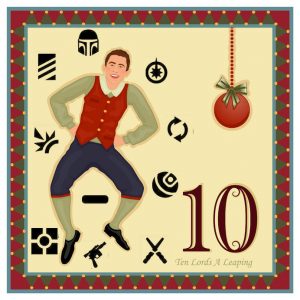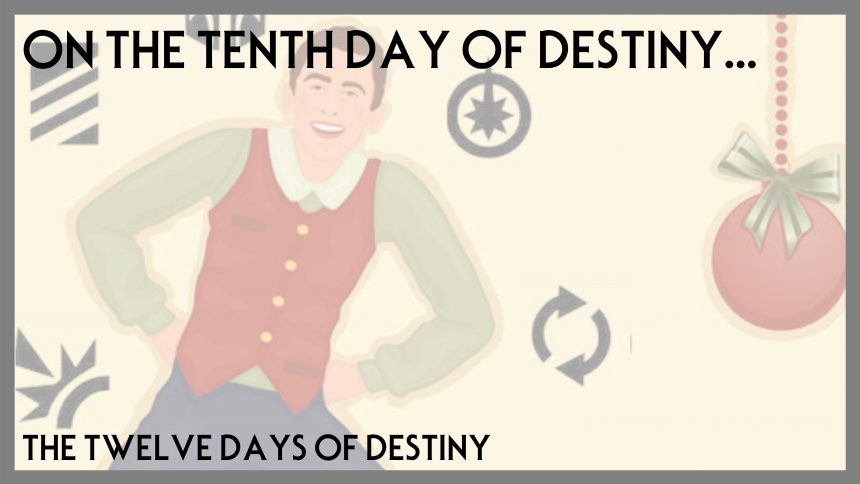We are deep in the holiday season, and I have to admit that I get a bit…enthusiastic…about Christmas. To that end, I thought it might be fun to take a shot at a “12 Days of Destiny” series of articles that highlight twelve wonderful (or at least impactful) things that Destiny has brought to us. The Tenth Day of Destiny celebrates everything we want to see (and don’t want to see) when we roll in.
On the Tenth Day of Destiny, FFG Gave to Me…Ten Symbols a-Showing

Janky no/low dice decks aside, Destiny ultimately comes down to the ten die symbols that we see rolled in each game. One of the first questions you have to ask yourself when building a deck is “What is this deck supposed to do?” and much of the answer to that question will revolve around these ten symbols. Whether you’re looking for heavy hitting characters, a way to ramp quickly into resources, or to control your opponents’ options, you’ll find most of your answer on the dice. So let’s take a brief look at each, starting with everyone’s favorite.
Blank
Admit it, you sometimes forget that blanks are technically symbols even though it feels like they’re always showing on your dice. But they are, and that can come in handy when you need to remove dice showing a particular symbol. And a few cards in the game even leverage blanks. My favorite of these was always Feel Your Anger. Not only does your opponent have blanks in their pool but then you get to remove their good dice as well? Ouch.
Melee
Sticks – the dice symbol that dominates our favorite Jedi, Sith, and the vicious lightsabers that they wield. I probably tend toward melee based decks than ranged based decks so this is my favorite damage type for no particular reason.
Ranged
Guns – the dice symbol that represents all of their various weapons that go “pew” in Star Wars. Maybe one reason that I prefer Melee is due to the tendency of these bad boys to get Deflected back into your face during the Awakenings meta.
Indirect
The newest kid on the block of damage symbols, indirect represents…well…I don’t know what it represents? And what should we call it since Indirect is a bit of a mouthful? Bombs? I’m going to go with Bombs. “Sticks, Guns, and Bombs” has a good ring to it. Indirect damage largely represents damage that would splash (like Planetary Bombardment) but also seems to be used to represent less precise damage (like some of the blasters in the game). Either way, my favorite/least favorite thing about Indirect Damage is that it forces your opponent to decide where the damage goes, and I hate distributing damage to my own characters.
Shield
Can we call this one “Hats?” “Sticks, Guns, Bombs and Hats!” These nifty little Mandalorian helmets are what protect your characters’ precious faces from the lightsabers, rocket launchers, and artillery that constantly bombard them. Wait…y’all…this is some really good armor now that I think about it! I tend to undervalue shields, but it’s always good to remember that taking a shield is effectively like removing a die that does 1 damage and that’s sometimes pretty important.
Resource
Money! Sure, resources are meant to exactly represent credits, but we all know that’s how we think of them anyway. Resources are what you need to equip your characters, play your supports, resolve high value dice sides, and hope to mitigate your opponent’s board state. Sitting on a huge pile of them always feels good, and few things hurt more than losing them.
Disrupt
Want to control your opponent’s game? Take their money. Disrupting your opponent’s resources leaves them with upgrades and supports left unplayed, dice left unmitigated, and high value dice left unresolved. All of these can set them enough behind the curve that it helps nudge you closer to victory. So don’t be too hasty to reroll those sides; your opponent is often hoping that you do.
Discard
This side is probably my favorite because it’s so savage. Having cards discarded from your hand means forfeiting options – options for dice mitigation, options for upgrades/supports to play, and options to reroll your dice. Having your hand stripped of its last card early in a round is one of the worst feelings in the entire game if you ask me.
Focus
Don’t like what you rolled? That’s fine. Focus let’s you change it to whatever you want. That’s good for obvious reasons so I’m not sure there’s much to say here other than to mention the value in chaining Focuses. A single one-focus side can be enough to result in a chain of focus actions that fixes three or four dice, and that’s pretty good.
Special
The wildcard symbol, Specials require you to consult the die’s card to see what they do. The designers have been truly creative with Special symbols and we’ve seen them do any number of things, ranging from all of the basic functions of the other symbols to just outright defeating a character.
Support The Chance Cube
Do you enjoy the content provided by The Chance Cube? Would you like to connect even further with The Chance Cube Family? Consider supporting this content by joining our Patreon. We are a team dedicated to media coverage and community building, committed to bringing you the best of this game, sharing the joy and community that comes with it. Our Patreons enjoy membership in The Chance Cube Hangout, our Facebook group for supporters of the channel, and we have additional tiers that include gifts from us to you as a thanks for the generous support. Find out more at patreon.com/thechancecube.
